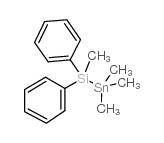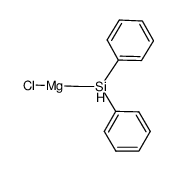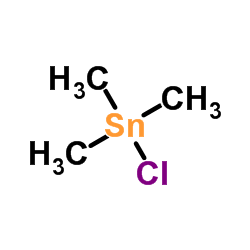149013-84-3
| Name | diphenyl(trimethylstannylmethyl)silane |
|---|---|
| Synonyms |
MFCD00800634
Trimethylstannylmethyldiphenylsilan TRIMETHYLSTANNYLMETHYLDIPHENYLSILAN,96 |
| Boiling Point | 125-130ºC |
|---|---|
| Molecular Formula | C16H22SiSn |
| Molecular Weight | 361.13200 |
| Exact Mass | 362.05100 |
| LogP | 3.29600 |
Synonym:None Section 2 - COMPOSITION, INFORMATION ON INGREDIENTS
Risk Phrases: 26/27/28 36/38 50 53 48/23/25 Section 3 - HAZARDS IDENTIFICATION EMERGENCY OVERVIEW
Very toxic by inhalation, in contact with skin and if swallowed. Irritating to eyes and skin. Very toxic to aquatic organisms. May cause long-term adverse effects in the aquatic environment. Toxic : danger of serious damage to health by prolonged exposure through inhalation and if swallowed. Potential Health Effects Eye: Causes eye irritation. Skin: Causes skin irritation. May be absorbed through the skin in harmful amounts. Ingestion: Harmful if swallowed. May cause gastrointestinal irritation with nausea, vomiting and diarrhea. Inhalation: Harmful if inhaled. Causes respiratory tract irritation. Chronic: Exposure limits have been recommended for organotin compounds to minimize the potential for adverse effects on immune function and the CNS. The critical effect of trimethyltin and triethyltin derivatives is on the CNS. Section 4 - FIRST AID MEASURES Eyes: Immediately flush eyes with plenty of water for at least 15 minutes, occasionally lifting the upper and lower eyelids. Get medical aid. Skin: Get medical aid. Flush skin with plenty of water for at least 15 minutes while removing contaminated clothing and shoes. Wash clothing before reuse. Ingestion: Never give anything by mouth to an unconscious person. Get medical aid. Do NOT induce vomiting. If conscious and alert, rinse mouth and drink 2-4 cupfuls of milk or water. Inhalation: Remove from exposure and move to fresh air immediately. If not breathing, give artificial respiration. If breathing is difficult, give oxygen. Get medical aid. Do NOT use mouth-to-mouth resuscitation. Notes to Physician: Treat symptomatically and supportively. Section 5 - FIRE FIGHTING MEASURES General Information: As in any fire, wear a self-contained breathing apparatus in pressure-demand, MSHA/NIOSH (approved or equivalent), and full protective gear. During a fire, irritating and highly toxic gases may be generated by thermal decomposition or combustion. Runoff from fire control or dilution water may cause pollution. Extinguishing Media: Use water spray, dry chemical, carbon dioxide, or appropriate foam. Section 6 - ACCIDENTAL RELEASE MEASURES General Information: Use proper personal protective equipment as indicated in Section 8. Spills/Leaks: Absorb spill with inert material (e.g. vermiculite, sand or earth), then place in suitable container. Clean up spills immediately, observing precautions in the Protective Equipment section. Provide ventilation. Section 7 - HANDLING and STORAGE Handling: Avoid contact with eyes, skin, and clothing. Keep container tightly closed. Avoid ingestion and inhalation. Use with adequate ventilation. Wash clothing before reuse. Storage: Store in a tightly closed container. Store in a cool, dry, well-ventilated area away from incompatible substances. Do not expose to air. Store under an inert atmosphere. Section 8 - EXPOSURE CONTROLS, PERSONAL PROTECTION Engineering Controls: Facilities storing or utilizing this material should be equipped with an eyewash facility and a safety shower. Use adequate general or local exhaust ventilation to keep airborne concentrations below the permissible exposure limits. Exposure Limits CAS# 149013-84-3: United Kingdom, WEL - TWA: (listed as tin organic compounds): 0.1 mg/m3 TWA (except cyhexatin, as Sn) United Kingdom, WEL - STEL: (listed as tin organic compounds): 0. mg/m3 STEL (except cyhexatin, as Sn) United States OSHA: 0.1 mg/m3 TWA (as Sn) (listed under Tin orga compounds). Belgium - TWA: (listed as tin organic compounds): 0.1 mg/m3 VLE ( Sn) Belgium - STEL: (listed as tin organic compounds): 0.2 mg/m3 VLE Sn) France - VME: (listed as tin organic compounds): 0.1 mg/m3 VME (a Sn) France - VLE: (listed as tin organic compounds): 0.2 mg/m3 VLE (a Sn) Germany: (listed as tin organic compounds): 0.1 mg/m3 VME (as Sn) Germany: (listed as tin organic compounds): Skin absorber Malaysia: (listed as tin organic compounds): 0.1 mg/m3 TWA (as Sn Netherlands: (listed as tin organic compounds): 0.2 mg/m3 STEL (a Sn) Netherlands: (listed as tin organic compounds): 0.1 mg/m3 MAC (as Spain: (listed as tin organic compounds): 0.1 mg/m3 VLA-ED (as Sn Spain: (listed as tin organic compounds): 0.2 mg/m3 VLA-EC (as Sn Personal Protective Equipment Eyes: Wear chemical splash goggles. Skin: Wear appropriate protective gloves to prevent skin exposure. Clothing: Wear appropriate protective clothing to prevent skin exposure. Respirators: A respiratory protection program that meets OSHA's 29 CFR 1910.134 and ANSI Z88.2 requirements or European Standard EN 149 must be followed whenever workplace conditions warrant respirator use. Section 9 - PHYSICAL AND CHEMICAL PROPERTIES Physical State: Liquid Color: clear, colorless Odor: stench pH: Not available. Vapor Pressure: Not available. Viscosity: Not available. Boiling Point: 125-130 deg C Freezing/Melting Point: Not available. Autoignition Temperature: Not available. Flash Point: Not available. Explosion Limits, lower: Not available. Explosion Limits, upper: Not available. Decomposition Temperature: Solubility in water: Specific Gravity/Density: Molecular Formula: C16H22SiSn Molecular Weight: 360.93 Section 10 - STABILITY AND REACTIVITY Chemical Stability: Stable at room temperature in closed containers under normal storage and handling conditions. Conditions to Avoid: Exposure to air, excess heat. Incompatibilities with Other Materials: Strong oxidizing agents. Hazardous Decomposition Products: Carbon monoxide, carbon dioxide, tin/tin oxides. Hazardous Polymerization: Has not been reported Section 11 - TOXICOLOGICAL INFORMATION RTECS#: CAS# 149013-84-3 unlisted. LD50/LC50: Not available. Carcinogenicity: Trimethylstannylmethyldiphenylsilan - Not listed by ACGIH, IARC, or NTP. Section 12 - ECOLOGICAL INFORMATION Other No information available. Section 13 - DISPOSAL CONSIDERATIONS Dispose of in a manner consistent with federal, state, and local regulations. Section 14 - TRANSPORT INFORMATION IATA Shipping Name: ORGANOTIN COMPOUND, LIQUID, N.O.S. Hazard Class: 6.1 UN Number: 2788 Packing Group: II IMO Shipping Name: ORGANOTIN COMPOUND, LIQUID, N.O.S. Hazard Class: 6.1 UN Number: 2788 Packing Group: II RID/ADR Shipping Name: ORGANOTIN COMPOUND, LIQUID, N.O.S. Hazard Class: 6.1 UN Number: 2788 Packing group: II Section 15 - REGULATORY INFORMATION European/International Regulations European Labeling in Accordance with EC Directives Hazard Symbols: T+ N Risk Phrases: R 26/27/28 Very toxic by inhalation, in contact with skin and if swallowed. R 36/38 Irritating to eyes and skin. R 48/23/25 Toxic : danger of serious damage to health by prolonged exposure through inhalation and if swallowed. R 50 Very toxic to aquatic organisms. R 53 May cause long-term adverse effects in the aquatic environment. Safety Phrases: S 26 In case of contact with eyes, rinse immediately with plenty of water and seek medical advice. S 27 Take off immediately all contaminated clothing. S 28A After contact with skin, wash immediately with plenty of water. S 45 In case of accident or if you feel unwell, seek medical advice immediately (show the label where possible). S 60 This material and its container must be disposed of as hazardous waste. S 61 Avoid release to the environment. Refer to special instructions/safety data sheets. WGK (Water Danger/Protection) CAS# 149013-84-3: No information available. Canada None of the chemicals in this product are listed on the DSL/NDSL list. CAS# 149013-84-3 is not listed on Canada's Ingredient Disclosure List. US FEDERAL TSCA CAS# 149013-84-3 is not listed on the TSCA inventory. It is for research and development use only. SECTION 16 - ADDITIONAL INFORMATION N/A |
|
~% 
149013-84-3 |
| Literature: Champion, Brian K.; Heyn, Richard H.; Tilley, T. Don; Rheinglod, Arnold L. Journal of the American Chemical Society, 1993 , vol. 115, # 13 p. 5527 - 5537 |
|
~% 
149013-84-3 |
| Literature: Journal of the American Chemical Society, , vol. 115, # 13 p. 5527 - 5537 |
| Precursor 1 | |
|---|---|
| DownStream 0 | |

